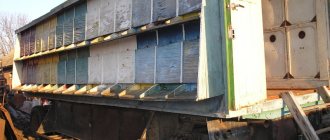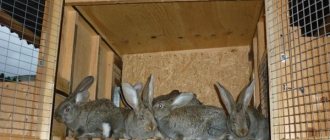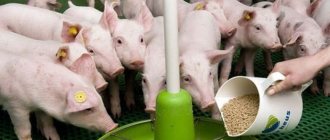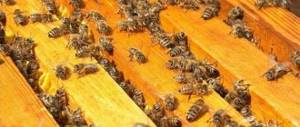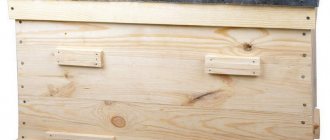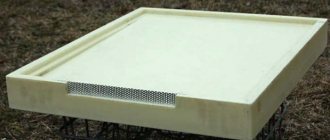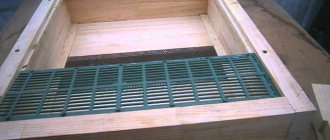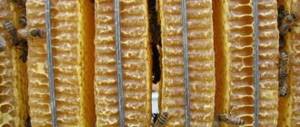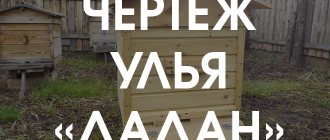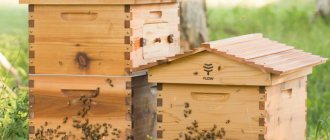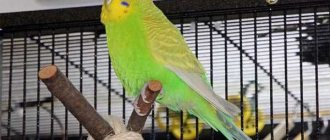What is a bee nuc?
A nucleus is, in fact, a reduced hive into several frames or a small family with one infertile or fertilized queen. The term "nucleus" is translated as "core".
In this case, we mean the core (base) of a bee colony, from which a large, strong bee colony can grow. Nucleuses are built in such a way that a large family simply cannot fit in them.
They are collected from 700-1000 worker bees, not counting the queen. The internal organization is similar to a full-fledged family, but there are significant differences. There are very few bees - there is not enough labor.
Such a family will not be able to provide itself with honey for the winter. Vulnerable to attacks from other bees.
But these disadvantages are also an advantage, because knowing about their “precarious position,” bees in nucs develop much faster than in ordinary hives.
Depending on the size of the nest, honeycombs, nucs come in different types:
- large, for the entire nesting frame;
- medium ones with reduced frames and micro-nuclei.
Design:
Advantages and types of artificial propagation
Artificially increasing the number of bee colonies is always a planned event for which beekeepers prepare in advance. Queens are bred from nests with the best productivity, and then layering is formed taking into account the strength of specific bee colonies and the time remaining until the main honey harvest of the year.
A properly formed family manages to gain strength - the income from such a hive, received from the sale of honey, will pleasantly please the owners.
Artificial propagation or swarming is carried out in several ways. Here are the most common ones:
- Layers are formed from one donor family or several nests that match the parameters - they are called prefabricated nests.
- Strong bee colonies are divided in half. Among beekeepers, this division is called half-flight.
- A raid is made on the queen cell with brood or on the queen placed in the new hive.
Why do birds eat bees?
The first method is most often used, as it is the simplest and most understandable for beginners . Donor hives are selected, in which healthy and strong families live. From these, food and brood frames with part of the worker bees are selected. As noted above, you can assemble a new nest using one donor or several families.
The second method allows you to form two bee colonies of equal strength . Insects of different ages are taken from the original hive and distributed evenly between the two nests. Bee houses are installed at an equal distance from the previous habitat of the donor colony. They are rearranged with an equal number of brood and food frames, dividing the insects equally. Dispersing (flying) bees return home in the evening, also evenly dividing between the two hives.
The third method helps to increase the strength of a new bee colony using flying insects from the donor hive . To do this, take a new bee house, transfer a frame with a working old queen into it, as well as two frames with sealed brood, three with artificial foundation and four with dry food and honey reserves. The hive is installed in place of the donor, and the original family is moved to another place and given a young queen.
The formation of layering to increase the apiary will be especially effective if fertile breeding queens are used for planting in new nests.
They are purchased from southern beekeeping farms that professionally engage in queen breeding. Here, fertile females are obtained at an earlier date, when in the northern regions the breeding and mating of bee “queens” is not yet possible due to weather conditions.
Purpose
The core has several purposes:
- Obtaining young queens.
- Fertilization of the uterus. It is not profitable to fertilize queens in normal hives in a large apiary. This requires a lot of drones, and they do not bring much benefit. Therefore, several nucs are usually made, where beekeepers receive new queens, including fertilized ones. Increase in the number of worker bees.
- The increase in family size in a nucleus occurs many times faster than in a conventional hive.
- It is much easier to form new families in nucs. If you do this right in the hive, you need to constantly watch the bees, check their condition, where they are. And so the problem disappears. Nucleus greatly simplifies the work.
What is a core needed for?
When using a nucleus, beekeepers assign the following basic functions to it:
- industrial breeding of queens;
- fertilization of queens, which is less beneficial as part of a full-fledged family;
- maintenance of reserve fetal uteruses.
In the old days, beekeepers did not resettle the formed colony into a separate mini-hive, but fenced off space for them in the same hive with the bee family. However, this type of content was fraught with too many problems . In particular, it was necessary to ensure that there were no holes in the partition separating the family from the nucleus. That's why one day it was decided: to resettle - just to resettle.
The nucleus is created to remove the fetal uterus - most often. Let's calculate the losses for the usual change of uterus in a family.
- The young queen flies out for fertilization no earlier than on the 6th day, and only if the weather permits.
- Bees are often given a mature queen cell, which plus another day or two. “Mature” is a 14-day-old queen cell in which the bees have chewed off the waxy top, exposing the cocoon. They do this for the convenience of the emerging uterus.
- It is impossible to remove the fetal one, replacing it with a queen cell or an infertile uterus: they will kill. It takes time for the bees to feel the orphanhood, then, with precautions, they give the queen cell. They may not accept it; repeated attempts will be required (more time).
- The young queen does not immediately develop high egg production; she “swings” for some time.
Therefore, they create a small family (nucleus), where the uterus is fertilized. This is an additional family; literally a handful of bees are taken from the main one, which is unimportant for it. After a short time, the beekeeper receives a fertile uterus.
It is also used as storage for a spare queen. Her death is the loss of her family. If this happens, often during the winter, the nucleus and the queen are attached, preserving a full-fledged family. It is not possible to store the queen bee in a different way - without bees, or several pieces per family: the bees are against it. Biology doesn't allow it. Each family has only one queen. An exception is that sometimes during swarming or quiet shifts, several exist simultaneously for a short time.
Basic principles of catching bee swarms
After fertilization, they act differently. For example, you can select the fetal uterus and reuse it. Again we substitute the mother liquor and start the cycle again. You can leave it, add brood and add frames.
Goal: to turn over time into a full-fledged unit in the apiary, but it can also be disbanded by joining an ordinary family.
Formation of a bee colony
Honeycombs in a nucleus
It is necessary to form families in a nucleus only from developed, large families during the period of main honey collection or swarming.
All work must be done before the afternoon, when the hives are almost empty - there are only guards, brood and nurse bees in them.
Depending on climatic conditions, there are slight differences in how to form a bee colony:
In the southern, warm regions, 1 frame with brood and 2 with food (beebread and honey) are installed. It is also necessary to place approximately 300 worker bees there.
In cold and temperate climates (central and northern regions), it is necessary to install 2 frames with brood and the same number with food. At least 600 worker bees are needed.
The brood is taken sealed, and there should be at least 2 kg of food. A ripening queen cell is also placed in the nucleus. If the queen is not fertilized, she is placed in a cage, placed in the hive, but released only after 3-5 days.
Important! When forming the nucleus, it is worth making sure that the queen is not transferred from the main hive.
Hatching of the queen in the nucleus
An empty space in the main hive from which the brood was taken, and the food is filled with fresh honeycombs with foundation.
The nucleus needs to be well insulated, the size of the entrance should be reduced so that only the bee can pass through it. And during the mating period, the uterus increases it.
When the frame with the brood becomes empty (the young bees come out and the honeycombs), the beekeeper needs to remove these honeycombs and install new ones in their place, with larvae, in order to load the young bees with work.
But this is done only before the uterus begins to lay eggs.
Interesting! After young animals appear in the nucleus, the bees relocated to form a new family usually return to their old hive.
How do small families spend the winter?
Beekeepers know that in order for a family to have a good winter, several requirements must be met. The requirements for the survival of a nucleus in winter are even more stringent:
- For a good wintering, there must be a sufficient number of young bees in the hive. Only the queen, placed no later than July 25–30, is capable of producing the required number of young bees. When placing the queen in August, not all the young bees will fly around, and the colony will not gain strength. Weak families die in winter.
- The nucleus is fed with sugar syrup. The proportion of sugar is 1/1.5 to water. The nuc eats about 300 grams of syrup per day and is fed every other day. It is necessary to feed at least two liters of syrup. If honey collection continues , no additional measures need to be taken for now. They begin feeding with syrup at the end of August and continue in mid-September.
- Add a honey frame to the sides of the club. They are prepared in advance in the main families for this. Only fully sealed frames are suitable.
How much honey does one family produce per season?
Bee traps: instructions on how to make them yourself
Thus, prepared mini-families can be considered ready for wintering. The last step remains: to assemble the nest for the winter.
Wintering
Wintering bees in nucleuses must undergo certain preparation:
- The family should be as developed as possible. To do this, the queen is moved for the last time on July 25, no later. It is from this that seeding will come.
- If the honey harvest is completed ahead of schedule, it is necessary to feed the bees with sugar syrup in a ratio of 1:1.5. A small nuc uses 250-350 g of syrup per day. Sometimes feeding is carried out once every 2 days, and not daily. In total, approximately 2 liters of syrup are fed.
- For each small family, prepare 3-4 half-frames of honey. They are usually taken from large hives that already have a lot of honey. Source:
When cold weather sets in, the nucleus is moved to the winter hut for bees and placed on the upper tiers of racks.
It is there that heat will be directed from the families in the hives located below and the bees in the nucleus will not freeze.
Benefits of use
These miniature hives are used to house barren queens. However, they are kept in them exactly until the moment of mating.
Another function is the temporary placement and storage of a duplicate fetal uterus.
Before this device came to the masses, beekeepers used ordinary hives and slightly modified them: they were divided into a certain number of compartments by partitions. Each of the compartments had, as a rule, from two to six frames, as well as a taphole, which was directed in the direction opposite to the other taphole.
A queen was placed in each of the resulting compartments, on the basis of which the family was raised. It is quite difficult to call this method optimal due to a large number of disadvantages, including:
- poor ventilation or its complete absence;
- poor conditions for wintering and, as a result, rapid wear and tear of worker bees;
- loss of heat and, accordingly, honey.
The use of cores in beekeeping not only eliminated the listed disadvantages, but also provided significant advantages:
- use of available materials from the “economy” price segment in the design;
- the possibility of wintering bees directly in the nucleus;
- good ventilation, which is provided by large space under the frames;
- using partitions, you can turn one core into several by dividing it into parts;
- versatility - in addition to its main function, the nucleus can also serve as a layer or trap for a “vagrant” swarm.
Nuclei for bees are actually just a kind of living space intended for these hardworking insects, in which they are not contained in single quantities, but as part of an entire colony. What are they for?
With the help of such devices, the owner of the apiary will be able to develop the population of his pets. Beekeepers are well aware that such a hobby is associated with numerous manipulations to separate strong families and connect weak families to them.
If there are two queens in a family, then they urgently need to be separated from each other. The features of such a bee house are ideal for such purposes.
What is a nuc in beekeeping? This is a special hive, which is a kind of construction kit. It is not always possible for the owner of an apiary farm to install additional hives on his territory.
In this case, if it is necessary to separate families, there is no need to purchase additional houses; you can simply install a partition inside such a bee dwelling. Thus, from one hive you can make several.
Breeding insects has its own characteristics, depending not only on the home you choose for your pets, but also on the breed of honey insects you choose. In addition, different breeds require different houses.
Choosing a breed is a separate and important issue for a novice beekeeper. Which option should he choose?
There are many different factors to consider here. In particular, the climatic factors existing on the territory of your apiary farm are of no small importance.
One of the most popular breeds at the moment is the Buckfast. This breed was artificially bred by man by crossing two other breeds, namely Ligustica and Melifera.
What are the advantages of the Buckfast breed? These individuals have the following features:
- efficiency;
- productivity;
- resistance to various diseases;
- winter hardiness.
They can be kept in the houses we are considering today. If you follow the recommendations of professional beekeepers, you can create a truly strong and productive family in such a home in a short period of time.
It is believed that the honey productivity of this breed is 180%. In addition, the individuals are very calm, it will be very easy to monitor them: they sit quietly in their place and are not prone to the swarming process.
The man who developed this breed is brother Adam. This English monk devoted his entire life to creating highly efficient breeds of honey insects.
How to do it yourself?
Despite the simplicity of the work, it must be started after preliminary preparation:
- prepare a drawing;
- purchase polystyrene foam sheets;
- prepare the tool.
The design will be miniature; for ease of use, provide carrying handles.
The result is a cute mini hive that is easy to move from one place to another.
Dimensions, shapes are as shown in the image:
Such a hive is divided by partitions, highlighting several full-fledged compartments.
Tools and materials
To make a core, you need to prepare the following tools:
- expanded polystyrene sheets;
- a knife, a stationery knife will do;
- screwdriver;
- self-tapping screws;
- ruler;
- glue.
But all this will be needed only after the drawings have been prepared.
Blueprints
To make bee nucs with your own hands, you need to choose a ready-made drawing or draw it yourself.
You can take the proposed option as a basis:
This mini hive is designed for one or more queens. The production process is simple and consists of several stages.
Design
You should adhere to the proposed technology in order to make a hive that is comfortable for the queen and a small family:
- Apply markings on the sheets in accordance with the drawing.
- Cut out all the details using a knife.
- Grease the ends with glue.
- Press the parts and hold until they are completely fixed.
- Make a hole for the entrance.
It is not necessary to adhere to the specified parameters. This is not important. Especially if you plan to place several queens.
But the drawing shows standard sizes. After the base is sufficiently firmly connected, proceed to further manufacturing.
It is necessary to secure the bottom and the slats for the partitions. Maintain a small but equal distance between them.
Make a lid, the top of which is covered with a solid sheet of galvanized metal. Make holes for the entrances, install frames and you can form small families.
Do-it-yourself core manufacturing technology
For manufacturing, you will need to take polystyrene foam sheets no less than 30 mm thick. Stock up on the following tools: glue, a ruler, self-tapping screws, a stationery knife, a screwdriver.
How to make a nucleus
Of course, before you start making a core, you need to figure out how to make a core as correctly as possible. The core should start with a frame, which is assembled separately for each wall.
is knocked together from wooden blocks of any soft species, for example, pine. A fiberboard wall is nailed to one side of the frame, foam is inserted, and then secured with another layer of fiberboard.
This is how all the walls of the core, its bottom and roof are assembled. In addition, plywood trim is nailed to the roof.
Further, the creation of cores involves performing connecting work. To begin with, the side parts and ends are knocked together. Then the joints are coated with PVA glue. When assembling the walls, it is important that a right angle is maintained between them, and the edge to which the bottom will be nailed in the future must be smooth. The bottom is nailed to the assembled walls. A rack liner is nailed to the upper edges of the walls.
When the nucleus is completely assembled, holes are drilled into it, which should be located in the middle of the nest. It is important that the bottom entrance is in contact with the bottom (this allows the bees to throw debris through it).
Then comes the turn of finishing work. The outer side of the core needs to be oiled, and all the cracks in it need to be filled. However, the manufacture of cores is not limited to these works. The core is considered finally finished only after painting. Why are three colors of oil paint used? The first (white or silver) is for the roof, the second (yellow) is for one nesting area, that is, one side wall and end, the last (blue) is for another nesting area.
Making an Ozerov hive with your own hands
Painting the roof and bottom should be done especially carefully. Moreover, the color of the bottom does not matter much. In addition, it is advisable to cover the roof with some kind of water-repellent material, for example, polyethylene.
The core manufacturing process includes the following steps
- Take polystyrene foam sheets and make markings on them using the dimensions of the drawing, cut them using a stationery knife.
- Lubricate the surfaces with glue, clamp it tightly, then use self-tapping screws to connect everything.
- Carefully make a hole for the tap hole; it can be round or square.
- Inside the core you need to make folds with plastic corners to which the frames will be attached.
- Dry.
- Mini-hives made from polystyrene foam can be painted on top.
Core frames
Creating cores also involves preparing special frames. Usually a core has frames of such dimensions that by fastening two half-frames together you can get one standard one.
That is why the upper hangers are attached with staples separately to the frame.
There are two types.
- The first (470 mm) is used to make one half-frame from two (to use it in a standard hive).
- The second (260 mm) is for assembling half-frames.
The semi-frame of the core has the same side side as the usual Rutov frame, which has permanent dividers. However, the width of its upper part is not 37mm, but 36mm, which is done to increase the brood. The wire is stretched as in a regular frame in four rows.
Check-in
- We prepare the housing, arrange frames with food, beebread, wax or empty ones in the required quantity. Yes, the nucleus is usually placed on small frames, one-quarter the size of a regular Dadan frame. These are very miniature families.
- Shake off the required number of bees, approximately 200 g each, and close the entrance.
- We take it to the cellar for a while. Goal: the bees must sense the absence of the queen, otherwise the queen cell or queen will be destroyed.
- We transport the hive to another location. Then the flying bees will not fly to their old place. A family with bees of different ages develops better.
- We give a queen cell or, if available, a barren queen.
- We install it in the apiary.
If we form it next to the main family, in a special pocket, then we act differently. We open the side entrance in advance: some bees get used to using it. We select the required amount into this pocket and install a blank partition. The advantage is that we use ordinary frames, and the nucleus has bees of all ages, including flying ones.
The design must provide for ventilation: the entrances are closed. Although in the cellar, in the dark, you can open it. You just need to wait a little for the bees to calm down. You can even keep it in the cellar for several days: the queen still has to “grow up”; the queen that has just emerged from the queen cell cannot be fertilized.
And the gathering of bees, if they were not transported to another area, will be smaller. It is necessary to check the availability of not only food, but also water. It is convenient to place it in bottles with a fabric wick next to the tap hole. You can simply pour it into the honeycomb when we form the nucleus.
Nucleus made of polystyrene foam
Recently, apiary owners have been making small beehives from polystyrene foam.
But the main disadvantage of such nucs is that it is unsafe to keep the queen in them for too long. It is advisable to return it to a large hive immediately after fertilization.
The frame in the nucleus is small, so it is sown quickly, and then the queen is left without work. This can provoke an unpleasant situation, and the bee will fly away.
Making a mini hive from polystyrene foam is easy. Moreover, packaging material from household appliances is suitable.
Lightweight, durable, perfectly retains heat. This creates exceptional conditions for wintering without requiring additional insulation.
It is worth highlighting other advantages:
- does not deform;
- not subject to rotting;
- prevents moisture penetration;
- light, weightless;
- structural strength.
Sometimes bees begin to chew on the walls of their temporary home. This is another drawback that forces them to be promptly relocated from the cores.
How to transport?
If there is a need to transport “bee housing”, it is transported without a lid, with the holes of the entrance plugged.
The nomadic tray must be pressed tightly against the upper part of the partition so that the bees do not fly to neighboring parts during transportation.
This is the optimal method of transporting the structure and is recommended by the vast majority of experienced beekeepers.
